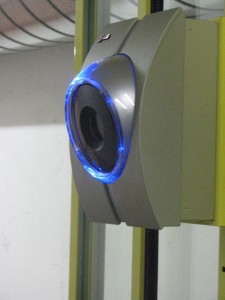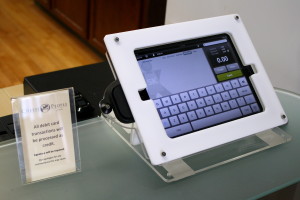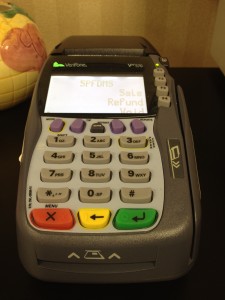October 21st, 2013 by Elma Jane
UL’s (Underwriter Laboratories) latest contribution to the future of payments has been accomplished through its three years of work with National Security, a French biometrics company that has created a commercially viable biometric technology solution for the point of sale.
The move positions UL and National Security at the forefront of an industry that is expected to expand by 140 percent to reach $12 billion in revenue over the next five years, potentially transforming online, mobile and in-store commerce by increasing the speed of transactions in the process.
Still, arguments can be made that biometric use at the point of sale will remain limited. Why does UL believe the market is right for biometrics, and how did it successfully ensure biometric payments will be ready for all parts of the payment process?
Why The Time Is Now For Biometrics
Consumer concerns regarding identity theft and violence are on the rise, and the solution according to many is a viable biometrics payment solution. Reports show that there is already strong demand in the U.S. and Asian markets for such products, and major research outlets have put their support behind the technology.
UL’s case study elaborates on the benefits illustrating how biometric data has been developed to be harder for hackers to infiltrate and compliant with EMV security standards.
Developing The Technology
UL’s work to ensure biometrics will remove friction at the POS has been extensive. For example, its latest case study profiles how UL developed the underlying technology to overcome challenges and work in harmony with wireless technologies such as bluetooth and Wi-Fi. Further, it explains how UL assessed the human health impact of National Security’s biometric solutions.
Posted in Credit card Processing, Electronic Payments, EMV EuroPay MasterCard Visa, Mobile Point of Sale, Near Field Communication, Point of Sale Tagged with: biometric, bluetooth, commerce, data, developing, EMV, future, hackers, identity theft, impact, in-store, mobile, online, payment process, payments, point of sale, POS, process, security standards, solution, speed, transactions, viable, Wi-Fi, wireless
October 21st, 2013 by Elma Jane
Retailers today collect email at every point of interaction. Collecting customer information in the store at the point of sale (POS) offers the greatest potential to build retailer’s email list quickly and to drive timely offers and communications that increase customer loyalty and retention.
The practice of collecting email addresses at the point of sale (POS) isn’t a new one. However, more companies are embracing the trend, and they’re doing so with increasing regularity.
E-Receipts
One popular technique among retailers is to ask shoppers if they would like a receipt emailed to them. It is important to note that an agreement to receive an e-receipt should not be necessarily interpreted as consent to be added to a commercial email list unless this intent is adequately communicated to the consumer and they consent. It always best practice to reference their consent to marketing emails at the same time as the e-receipt request.
It is possible to collect (PII) Personally Identifiable Information at the counter in a
careful and conscientious manner if you follow guidelines.
1. Be transparent about the commercial intent. A consumer who feels misled is more likely to complain and to seek redress under the consumer protection laws. If following different scripts is a challenge, apply the same disclosure/request script for both credit and cash transactions.
2. Consider using the credit card terminal or other touchpad device for customers to enter their email rather than using the sales associate. The device should first prompt the customer to consent to receiving an in-store e-receipt and/or marketing communications, ideally before proceeding with the transaction, it could be after as well.
3. Decouple PII collection from the credit card purchase. Ask customers for their email addresses before taking their credit cards or after they sign off on the purchase so it is clear that email is not required as part of the transaction.
4. Fulfill any incentives offered at the counter through email. Provide each consumer with a dynamic and unique link. A consumer will have less of a reason to give you a valid email address if you offer and fulfill the incentive at POS. Limiting the use of the incentive to email will help you avoid incentive abuse.
5. Send a welcome permission pass. Don’t assume that the customer wants anything more than an in-store e-receipt even if you can legally claim to have this right. Let the customer make an informed decision at the counter or in a subsequent email.
6. Validate submitted data. Ask customers to verify the accuracy of their PII before submitting. Use appropriate list management tools to prevent avoidable domain errors.
Clients that take the proper steps to overcome POS challenges and risks will reap the rewards of subscriber loyalty, a stronger reputation and better inbox performance in the long run.
Posted in Best Practices for Merchants, Credit card Processing, Electronic Payments, Gift & Loyalty Card Processing, Point of Sale Tagged with: associate, best practice, cash, commercial, communications, companies, consumer, credit, credit-card, customer, e-receipts, email, emailed, incentive, interaction, list, loyalty, offers, personally identifiable information, pii, point, point of sale, POS, retailers, rewards, sales, script, subscriber, timely, touchpad, transactions, transparent
October 18th, 2013 by Elma Jane
Cash registers were the only game in town not too long ago, but these days companies have many more choices. Replacing antiquated cash registers with modern POS (point of sale devices carries a number of important benefits, including:
1. Can cut down on user errors. Hitting a wrong key is always a risk when ringing a sale, but point of sale devices have built in checks to ensure that the information is entered accurately.
2. Customers receive more informative itemized receipts with a point of sale devices. Many cash registers can only print the date and the amount of the sale, but since point of sale devices are tied into the inventory control system they can provide much more detailed information, including a description of the item, the list price and the sale price.
3. Easy to look up past transactions. If you need to know how much you sold last Tuesday a point of sale system can give you that information in a snap. It would take many hours of laborious work to find the same answer using a cash register.
4. Maintenance and repair costs are often much lower on a point of sale device than a cash register. The number of companies that repair cash registers is dwindling, and that means that repair costs can be rather high. There are many vendors who repair point of sale devices, and that can keep repair costs low.
5. Provide faster service than old fashioned cash registers. Every part of the process, from authorizing a credit card transaction to printing a customer receipt, is faster on a point of sale device.
6. Simplify the accounting process. Old fashioned cash registers force accountants to sort through hundreds of receipts, but with a point of sale system financial personnel can simply use the built in reports or create their own.
7. Unlike a cash register, a point of sale system often includes an overall inventory management system. Store owners can use a point of sale system to track their biggest sellers and reorder those products when stock gets low.
8. Workers now a days are often more comfortable with point of sale devices than old fashioned cash registers. Generation now entering the workforce never knew a time without computers, and as a result they are very comfortable working with computerized technology like point of sale devices.
9. You can use a point of sale system to create your own purchase orders, eliminating an extra step in the ordering process. You can even automate the ordering process to make sure you never run out of your hottest selling products.
10. You can see real time inventory with a point of sale device, something that even the best cash registers simply cannot do. In fact, many companies have found that implementing a point of sale system virtually eliminates the need for a costly hand count.
There are many reasons why your company should consider state of the art point of sale device and ditching the old fashioned cash register. These devices can lower the cost of doing business while increasing productivity, and that can be good for the bottom line.
Ready to make the switch from a cash register to a point of sale system? National Transaction can provide the software, hardware and support for any POS need. NTC integrate your payment processing into many accounting software titles such as Intuit Quickbooks or Peachtree Accounting. NTC can also provide integation for any restaurant cash register system and all industry specific solutions. NTC provide credit card readers for Android, Apple and Blackberry smartphones and tablet devices. National Transaction can make the World your Point Of Sale.
Posted in Credit card Processing, Mobile Point of Sale, Point of Sale, Visa MasterCard American Express Tagged with: accounting, amount, Android, Apple, authorizing, benefits, blackberry, cash register, computerized, control, costs, credit-card, date, devices, hardware, inventory, itemized, low, maintenance, point of sale, POS, price, print, process, readers, receipts, reorder, repair, sale, sale price, Smartphones, software, stock, system, transactions, vendors, virtually
October 18th, 2013 by Elma Jane
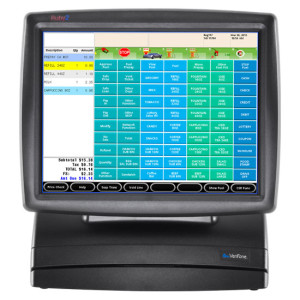
Verifone Ruby 2 POS
VeriFone Systems, announced today the availability of Commander Site Controller, the company’s next generation site management solution, and Ruby2 a touch-screen point of sale (POS) solution, both designed to provide greater efficiency, faster payment acceptance and new management capabilities that maximize profit potential for convenience store retailers.
Commander Site Controller is purpose-built for rugged c-store environments and combines site, payment and forecourt control in one device, creating additional flexibility in store configuration. Its future-proof system architecture includes expansion slots and ports for additional capacity and functionality. Additionally, Commander Site Controller features 100 percent IP communication for increased speed of EMV transactions.
Ruby2 is the next evolution of VeriFone’s Ruby POS platform, a 20-year leader in the petroleum industry. It features a fully-touchscreen console that increases checkout speed by providing fast and efficient order and payment processing, and a smaller footprint for increased counter space. Ruby2 is compatible with the latest VeriFone product offerings, including customer engagement media solutions, site management software to efficiently manage multiple locations seamlessly, and the latest in fuel control management.
VeriFone is taking petroleum retail and c-store operations to new heights of efficiency and manageability. These next-generation systems build on the success of Sapphire site controller and original Ruby POS systems with the ability to expand in order to meet customers’ future needs.
Commander Site Controller’s cloud based management software platform – Commander Console—enables owners to remotely and simultaneously complete PLU price changes, tax rate adjustments, fuel price changes and promotional updates in real time for multiple site locations from any web enabled device or mobile app for iOS and Android tablets and smartphones.
Ruby2 will be available this fall on certain networks while Commander Site Controller is available today on certain networks.
Posted in Credit card Processing, Electronic Payments, Mobile Point of Sale, Point of Sale Tagged with: acceptance, app, architecture, capabilities, capacity, command site controller, convenience, EMV, engagement, expansion, forecourt, iOS, management, mobile, networks, payment, plu, point of sale, POS, retailers, ruby 2, rugged, seemlessly, site, Smartphones, store, systems, touch-screen, touchscreen, transactions, verifone
October 17th, 2013 by Elma Jane
National Transaction Corporation’s services will work with any existing (Non Proprietary) Terminal. NTC can reprogram an existing terminal as well as service and provide supplies for any terminal.
Below are the following Terminals and Model Type:
1. Hypercom – They produce electronic payment processing hardware and software for a wide range of industries. In 2009 Hypercom co-founded founding the Secure POS (Point Of Sale) Vendor Alliance, a non profit organization created by Hypercom, Ingenico and VeriFone to increase awareness of and improve payment industry security. Hypercom entered into a merger agreement with VeriFone, which closed August 4th, 2011.
Hypercom Machines: T7P – T7Plus – T4100 – T4210 – T4220 IP Terminal. For Precise Detail of the machines please check our website. www.nationaltransaction.com
2. Ingenico – is a leading provider of payment solutions, with over 20 million terminals deployed in more than 125 countries. Ingenico is a worldwide company, whose business is to provide the technology involved in secure electronic transactions. Its traditional business is based around the manufacture of point of sale payment terminals, but it now also includes complete payment solutions and related services. In 2008, after the merging with SAGEM Sécurité, Ingenico decided to close its historical R&D centre in Barcelona. This centre has developed Ingenico’s most successful family of EFTPOS (Electronic funds transfer point of sale). More than three million units sold worldwide in 2007. Ingenico acquired German payment processor Easycash in 2009. In 2011, Ingenico integrated Pennies, The electronic charity box, into one of their market leading mobile Chip and PIN payment terminals, allowing retailers to ‘switch on’ the Pennies solution so their customers can add a micro-donation to their bill when paying by card. As of 2012, over 15 million Ingenico terminals are deployed across 125 countries, with the Ingenico Aqua 50 being their best selling POS (Point Of Sale) terminal.
Ingenico Terminals: iPP220 – iPP320USB – iCT220 PIN Pad – iCT250 CounterTop – Agua PCI – i5100 Dial – i7780 HandHeld i778oM – i7780 Versatile Base – 7770 Intel Base. For Precise Detail of the terminal please check our website. www.nationaltransaction.com
3. VeriFone – is a global provider of technology for electronic payment transactions an international producer and designer of electronic payment solutions and value-added services at the POS (Point Of Sale). VeriFone provides merchant-operated, consumer-facing and self-service payment systems for the financial, retail, travel & hospitality, petroleum, government and healthcare industries. The company’s solutions are utilized by merchants, processors and acquirers in developed and emerging economies worldwide.
VeriFone Models: OMNI 3730LE/VX510LE N – OMNI 3750 4MEG DUAL COM – VX 510 6 MB DUAL COM 12MB – VX570 DUAL COM 6MB WITH SMART CARD – VX610 CDMA (AVAILABLE FOR SPRINT AND VERIZONE). For Precise Detail of the models please check our website. www.nationaltransaction.com
Posted in Credit card Processing, Credit Card Reader Terminal, Credit Card Security, Electronic Payments, Near Field Communication, Point of Sale Tagged with: 15100 Dial, 7770 Intel Base, acquirers, aqua 50, Aqua PCI, Chip and PIN, eftpos, electronic, electronic funds transfer point of sale, financial, healthcare, hospitality, hypercom, i7780, iCT220 PIN Pad, IP, iPP220, iPP320USB, mobile, Omni 3730LE, Omni 3750, paying, payment, point of sale, processor, retailers, Security, T4100, T4210, T4220, T7P, T7Plus, travel, VX 510, VX510LE, VX570, VX610
September 10th, 2013 by Admin
Verizon annually releases it’s Data Breach Investigation Reports which probes data breaches in various industries and studies the nature of fraud reported by merchants and other agencies. In the past Verizon has worked with the U.S. Secret Service, now the information gathered on the electronic payment breaches have expanded to Police Central e-Crime Unit, Australian Federal Police, the Dutch National High Tech Crime Unit, and the Irish Reporting & Information Security Service in addition to the United States Secret Service.
One area that Verizon broke out and performed independent studies on was the healthcare industry. In 2010 the Health Information Technology for Economic and Clinical Health (HI TECH) Act included a provision to report healthcare and medical data breaches to a variety of outlets including the Secretary of Health and Human Services. Medical record protections keep the casual cyber criminal at bay but the majority of security data breaches are in large part targeted at information attackers can profit from. The data cybercriminals target most often includes health insurance data, personal and electronic payment transaction data. Hardware is another assett that is targeted both because of the data on the hardware and the cost of the hardware itself.
Remote data breaches on health care providers were typically carried out through some form of hacking or malware. That is consistent with other industries in the report and is considered the favorites among cybercriminal organizations. Exploiting of default or guessable credentials rang in at the top of the chart. Of those, point of sale payment systems and desktop computers were the highest targeted areas of the health care industry. Although electronic medical records and transcriptions stored on file and database servers were a target, those criminals were more likely interested in indentity theft and fraudulent loans than what was actually in any individuals medical records.
Point of sale payment terminals are the most targeted assett with POS servers and gateways as the second most targeted. Like all other sectors, professional criminals tend to follow the money trail and that ends up being at POS payment systems. So much so that even desktop computers and emails try to get malware onto medical systems to render security policies inneffective. To find out how to better protect medical and healthcare records from cybercriminals and data breaches read the reports here and here.
Posted in Best Practices for Merchants, Credit Card Security, Point of Sale Tagged with: Breach, breaches, electronic payment, gateways, healthcare, medical, point of sale, POS, Security, transactions, transcription
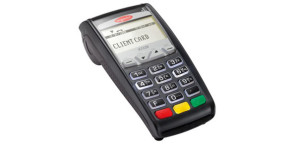
Ingenico iCT220 Credit Card Reader
Built on the Telium2 software platform, the iCT220 from Ingenico offers an operating system providing a secure standardized architecture for next generation Point of Sale or POS credit card reader terminals. Telium2 reinforces electronic payment security and integrates added features such as deleting sensitive data and terminal cut off. Dual processor architecture increases digital transaction speed. It also accommodates a wide range of electronic payment types. Read more of this article »
Posted in Electronic Payments Tagged with: credit card, electronic payment, point of sale, POS, Processing, terminal
Visa is going all out against cash driving the adoption of mobile payment services. In Europe Visa expects that over 50 million contactless payments will be made each month by years end. Head of Visa’s mobile business Sandra Alzetta expects a wave of NFC enabled smartphones from smartphone and tablet makers such as Samsung, HTC and LG. The European versions will ship with Visa’s mobile PayWave and Mobile wallet services driving their growth in mobile payment services. Read more of this article »
Posted in Mobile Payments Tagged with: Digital Wallet, HTC, LG, nfc, point of sale, POS, Samsung, Visa MasterCard American Express
